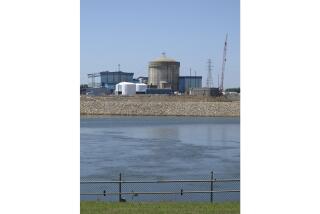Nuclear Warhead Safety Problems Cited : Arms: One missile will ‘probably’ be retired from alert status. A Navy weapon also is questioned.
- Share via
WASHINGTON — Energy Department officials acknowledged Wednesday that several types of nuclear warheads in the U.S. arsenal have been plagued by safety problems that could cause them to burst open and scatter radioactive cancer-causing debris over a wide area.
The officials told the Senate Armed Services Committee that all the weapons are now safe, but that conclusion was undercut by testimony from the directors of the three national U.S. laboratories.
Moreover, the Energy Department’s most senior nuclear weapons official conceded that one of the troubled weapons, an air-launched missile widely deployed in the United States and Europe, will “probably” be retired from alert status in the wake of discoveries that the warhead could break apart if caught in an aircraft fire.
“That’s the direction in which we’re going,” said John C. Tuck, the Energy Department’s undersecretary for defense programs. He added that the possibility of removing the Short-Range Attack Missile is being reviewed by Defense and Energy department officials.
The safety lapses in the nuclear warheads almost certainly would not result in a nuclear detonation, although scientists would not rule out such a theoretical possibility. More likely, they said, the problems could cause weapons that were dropped, burned or hit in the wrong place to spew radioactive dust over a large area.
In their testimony, the directors of the national laboratories warned that the nuclear warhead of the Short-Range Attack Missile is not safe and should be taken off those B-52, B-1 and FB-111 bombers that are on alert for short-notice missions.
“I personally would like to see the exposure (of the bomber missiles) reduced at this time,” said Albert Narath, president of Sandia National Laboratories. John Nuckolls, director of the Lawrence Livermore Laboratories, and Siegfried Hecker, director of the Los Alamos National Laboratories, agreed.
Nuckolls told reporters later that the odds of an accident involving the missiles are much less than one in 100.
Among the other weapons questioned on safety grounds was the W-88 warhead, the nuclear tip of missiles carried aboard the Navy’s Trident submarines.
The Washington Post, which first reported the nuclear dangers in its Wednesday editions, said that Energy Department investigators found that if the propellant of the missiles carried aboard Trident submarines caught fire, the W-88 warhead could spread nuclear debris or even detonate. If such an accident occurred during the loading of such missiles at Trident bases in Bangor, Wash., or King’s Bay, Ga., nearby population centers could be devastated, they reportedly concluded.
But Secretary of Defense Dick Cheney, speaking at a press conference in Brussels, said Wednesday that the W-88 “has been found and still is found a safe weapon when properly and safely deployed,” adding that it “does meet all the current nuclear explosive safety standards.”
Tuck added that nuclear weapons safety “receives high-priority attention” in the Energy Department, which oversees the production of nuclear weapons.
Energy Secretary James D. Watkins, a retired admiral, also testified before the panel, but in closed session only.
Tuck said that after the problems were discovered, starting in 1988, the Energy and Defense departments established a permanent safety committee to ensure that lapses are identified and addressed.
The most politically sensitive safety lapse was discovered in early 1988 in the W-79 nuclear artillery shell. The Post reported Wednesday that Energy Department investigators discovered that the warheads could burst open if hit forcefully in a sensitive spot.
More to Read
Sign up for Essential California
The most important California stories and recommendations in your inbox every morning.
You may occasionally receive promotional content from the Los Angeles Times.














